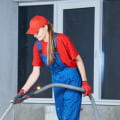Construction dust is an inevitable byproduct of any building or renovation project, and it can pose a serious nuisance and health risk if not properly managed. These fine particles linger in the air long after construction ends, affecting indoor air quality and potentially causing respiratory issues for occupants. Eliminating construction dust from the air requires a combination of thorough commercial cleaning in Sydney, NSW, air filtration, and preventive measures. Whether you’re a homeowner dealing with post-renovation dust or a contractor aiming to maintain a cleaner worksite, understanding effective ways to clear the air of construction dust is essential. Construction dust is an inevitable byproduct of any building or renovation project, and it can pose a serious nuisance and health risk if not properly managed. These fine particles linger in the air long after construction ends, affecting indoor air quality and potentially causing respiratory issues for occupants. Eliminating construction dust from the air requires a combination of thorough commercial cleaning in Sydney, NSW, air filtration, and preventive measures. Whether you’re a homeowner dealing with post-renovation dust or a contractor aiming to maintain a cleaner worksite, understanding effective ways to clear the air of construction dust is essential.
Immediate Post-Construction Clean-Up
The first step in tackling construction dust is a thorough post-construction clean-up. This process involves removing all visible dust and debris from floors, walls, and surfaces. Vacuuming with a high-efficiency particulate air (HEPA) filter is highly recommended, as standard vacuums often recirculate dust particles into the air. HEPA-filtered vacuums are designed to trap tiny particles and prevent them from becoming airborne, ensuring a cleaner space. Cleaning should also include wiping down walls, windows, ledges, and surfaces, as construction dust tends to settle in unexpected areas. For professionals like a kitchen remodeler, it’s crucial to ensure that all construction dust is removed, as it can contaminate food preparation spaces if left unchecked.
Using Air Purifiers and Filtration Systems
Air purifiers are an effective tool in removing airborne dust particles that linger even after surface cleaning. For optimal results, look for purifiers with HEPA filters, which can capture fine dust particles as small as 0.3 microns. Set up air purifiers in different areas of the home, particularly in rooms that were directly affected by construction, and allow them to run continuously for a few days after the renovation. Air purifiers not only trap dust but also help eliminate other airborne contaminants, such as allergens and mold spores, which may have been disturbed during construction.
Ventilation Techniques to Improve Air Quality
Proper ventilation is essential to expel construction dust from an indoor environment. Open windows and doors to allow fresh air to circulate and help push out dust-laden air. If possible, set up fans to create a cross-breeze, with one fan blowing air out of the space and another bringing in fresh air from a different direction. This airflow helps to quickly dilute and remove airborne particles. However, be mindful of outdoor weather conditions; on particularly windy days, dust may be blown back into the home, so adjust ventilation efforts as needed. If working with contractors, request they use negative air machines to capture dust at the source and prevent it from spreading throughout the space.
Tackling Hidden Dust with HVAC Maintenance
During construction, dust often infiltrates the HVAC (heating, ventilation, and air conditioning) system, which can lead to recirculation of particles throughout the building. To effectively reduce construction dust in the air, change HVAC filters immediately after the project is complete. Look for high-quality filters with a Minimum Efficiency Reporting Value (MERV) rating between 8 and 13, as these are more effective at capturing fine dust particles. In some cases, hiring a professional to clean the HVAC ducts may be necessary, especially after large-scale renovations, to prevent any residual dust from being recirculated.
Wet Cleaning Methods for Dust Control
Wet cleaning techniques are another effective way to manage construction dust. Use a damp mop or cloth to clean floors and surfaces, as this method captures dust rather than dispersing it back into the air. For walls and ceilings, consider using microfiber cloths, which are designed to trap dust particles without releasing them. Wet cleaning is particularly effective in areas with heavy dust buildup and can be repeated several times during the clean-up process. Be cautious with the amount of water used, especially on surfaces sensitive to moisture, as excess water can damage certain materials.
Preventive Measures During Construction
Preventing dust from becoming airborne in the first place can significantly reduce the post-construction clean-up required. During the construction process, consider setting up temporary barriers, such as plastic sheeting or dust curtains, to contain dust within the work area. Additionally, using tools with dust extraction attachments, like saws and sanders, can capture dust directly at the source, reducing its spread. Contractors should also make an effort to clean as they go, which minimizes the amount of dust that accumulates. For those working with a kitchen remodeler, discussing dust control measures before construction begins is beneficial, as kitchens are particularly sensitive areas that require strict cleanliness standards.
Monitoring Air Quality After Cleaning
Even after thorough cleaning, it’s essential to continue monitoring air quality for a few days, as dust can linger and resettle. Investing in an indoor air quality monitor can provide insight into the concentration of particulate matter in the air and help determine when additional cleaning or filtration may be necessary. Regularly changing air purifier filters and HVAC filters during the weeks following construction can also help maintain a dust-free environment. If air quality remains poor despite these efforts, consider seeking a professional cleaning service that specializes in post-construction cleaning.
Conclusion
Getting rid of construction dust in the air is a multi-step process that combines cleaning, air filtration, ventilation, and preventive measures. With the right approach, you can effectively remove dust particles and restore indoor air quality. Taking steps such as using HEPA-filtered vacuums, setting up air purifiers, and ensuring proper ventilation can make a significant difference in the post-construction environment. For those working with a professional, like a kitchen remodeler, discussing dust control practices upfront can help create a cleaner and safer space that’s ready to use once the renovation is complete. With diligence and the right tools, construction dust doesn’t have to be a lingering problem.



